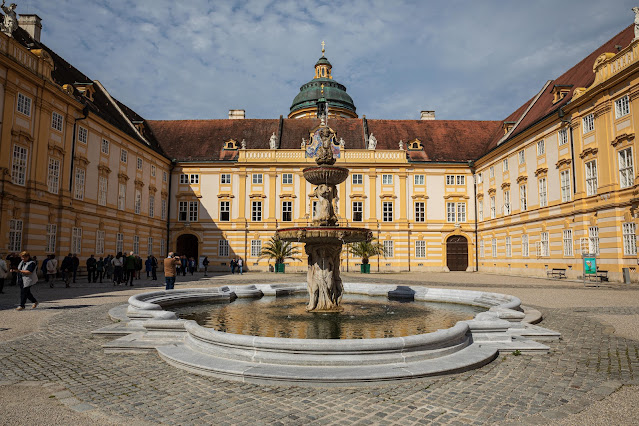I'm still trotting along with my husband to various geological meetings around the world. Most recently he was in Vienna where we had enough time to make a day trip to the Wachau Valley. A pleasant hour long drive took us to the Melk Abbey, an enormous complex perched on a rocky outcrop above the Danube and the town of Melk. Sadly, photography is not permitted inside the buildings so I cannot show you the impressive library, nor the over-the-top Baroque church interior.
Here you see the entrance to the complex and the church dome. Though the Benedictine abbey on this site dates back to 1089, the church in its current form was completed in 1736.
It is a still a working monastery and tours are limited to a number of rooms dedicated to displays about the history and purpose of the abbey, the library, and the church.
You can also wander the extensive grounds and gardens.
The terrace outside the library affords sweeping views of the town of Melk below, the Danube, and the surrounding countryside.
Here is church's front, which shares the same vibrant egg-yolk yellow color as much of the complex and hints at the treasures within.
Because I am a sucker for cobblestones and narrow passageways, here is an image from inside the complex. It is an atmospheric place and you can understand why Umberto Eco drew on this setting for his book "Name of the Rose."
Our next stop was Arstetten Castle, which compared to Melk with its busloads of visitors, is off the beaten path. Arstetten Castle is the present day home of the Hohenberg family, descendants of Archduke Franz Ferdinand, the presumptive heir to the Austro-Hungarian throne, and his wife Sophie, whose assassination in June of 1914 is credited with triggering WWI.
A portion of the house has been turned into a museum with displays on various facets of Franz Ferdinand's life, the Hohenberg family, and details of the assassination, including a reproduction of the open car in which Franz Ferdinand and Sophie were riding when they were shot.
We visited the crypt where Franz Ferdinand and Sophia are interred, and found it remarkably moving and intimate. I chose not to take photos, feeling it would be intrusive and disrespectful in this solemn and personal space.
We did wander through the grounds, enjoying the fresh air, long views,
and early spring flowers.
To cap off the day we stopped in Durnstein, a tiny but picturesque and very popular town along the Danube, best known perhaps for King Richard the Lionheart's imprisonment in its hilltop castle in 1192. We sadly didn't have time to climb to the castle, instead satisfying ourselves with a stroll along the main street.
I often find small details are essential to the character and charm of a place.
Having found eating establishments along the main street to be either too busy or not to our liking, our guide eventually led us down a side street to
Alter Klosterkeller, a family owned restaurant that proved to be the perfect choice.
Our table was right next to the just budding out vines leading down to views of the Danube and hills beyond.
We shared an unhurried and delicious meal of local specialties and crisp, local wines. It was a delightful ending to our day in the Wachau Valley.
I must give credit to the wonderful staff at our travel agency,
Travel Abundance, who arranged this perfect day trip (along with the rest of our adventures). They built an itinerary tailored to our interests and ensured that it was totally stress free.















No comments:
Post a Comment